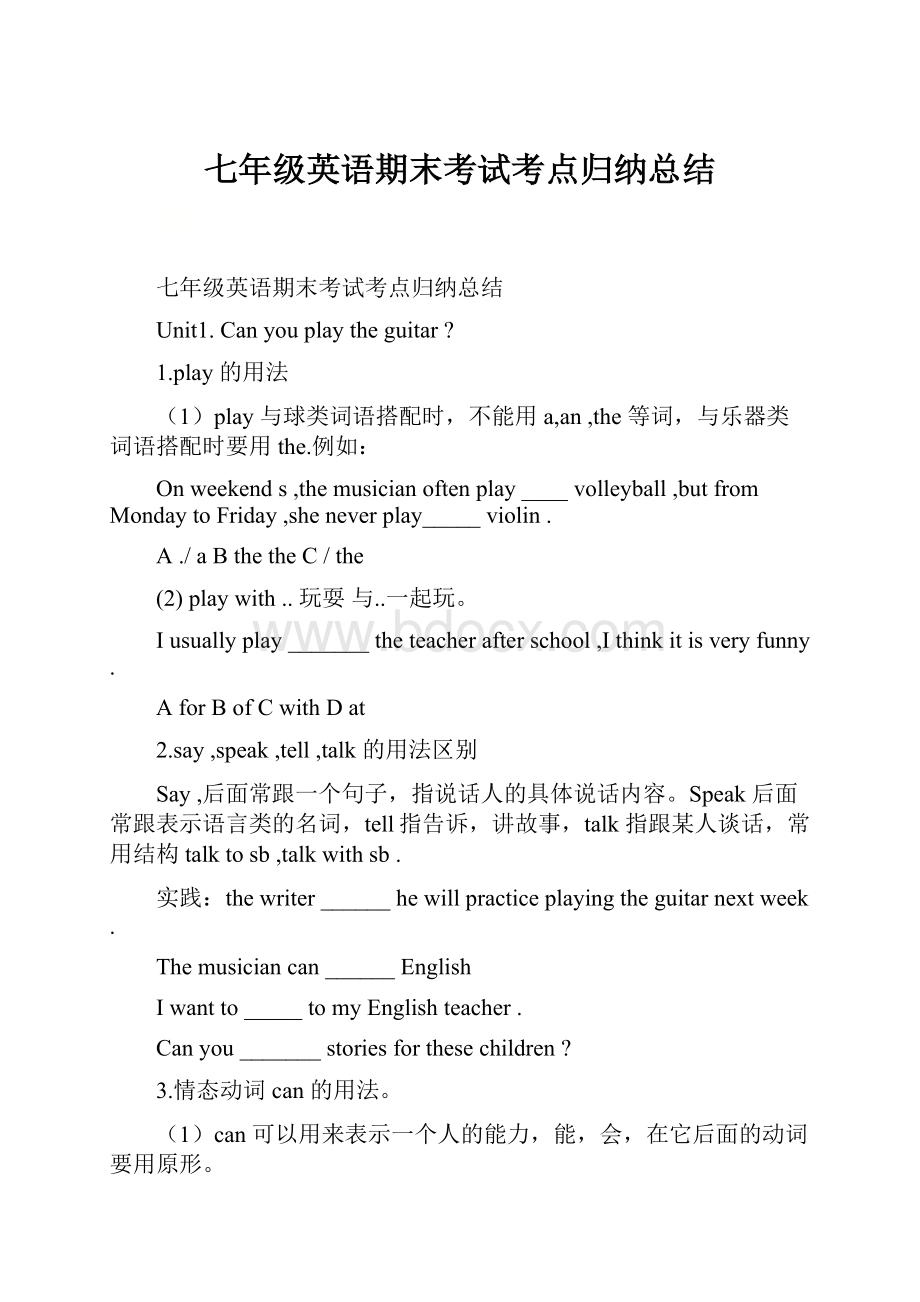七年级英语期末考试考点归纳总结文档格式.docx
《七年级英语期末考试考点归纳总结文档格式.docx》由会员分享,可在线阅读,更多相关《七年级英语期末考试考点归纳总结文档格式.docx(21页珍藏版)》请在冰豆网上搜索。

AwithcleanBwithcleansCwithcleaning
5.also,too,either用法辨析
三个词都表示“也”,其位置不同,also放入句中,too放于句末,either也放于句末,但只能用于否定句。
Thewriter_______wenttothefarmlastweek.
Themusicianfedsomechickens,_______
Thepeopledidn’tridehorses,_______onthefarm.
6.begoodat(doing)sth,擅长于..,擅长于做某事,begoodfor对..有好处,begoodwithsb,与..相处好。
Befriendlyto对..友好
Theteacherisgoodat___stories,andthemusicianisgood_____thechildren.
Atell,withBtells,withCtellingfor
Dtelling,with
7.本单元重点句型:
A:
whatclubdoyouwanttojoin?
B:
Iwanttojoin..club?
A:
whatcanyoudo?
B:
Ican...
Areyougoodat..?
Areyougoodwithchildren/...?
Unit2whattimedoyougotoschool?
1.表示时间的介词on,in,at的用法。
At主要表示几点几分,in表示时间段,常指inthemorning,intheafternoon,intheevening
On主要指在具体的哪一天。
Onthewindymorning,onMay8th.
Thedriveroftengetsup_____halfpastsix,andIusuallytakeashower______themorning,Bob’sbirthdayis____December21st.Aat,inonBatonin
ConinatDatinon
2.时间表示方法
(1)顺向表示法:
即小时+分钟
(2)逆向表示法:
分钟+时间。
当小于30分钟时,分钟past小时,当等于30分钟时:
halfpast...,当等于15分钟时,表示为:
aquarterpast..,当大于30分钟时,表示为:
分钟(60-实际分钟数)to小时(实际小时数+1),当分钟为45时,表示为aquarterto..
如:
7:
45at________________
6:
30at__________,5:
15at__________
8:
50at_______________.2:
45at_________
3.表示频率的副词有哪些?
Alwaysusuallysometimesoftenneverhardlyever.
4.itis+adj(forsb)todosth.常用此句型用来表示说话人对做某件事的观点和看法。
对于他来说,早上5:
30起床很奇怪。
It’svery______________________________
5.本单元表示一天的日常活动常用表达语:
Getupgetdressedbrushone’steeth,takeashower,washface,havebreakfast,gotoschool,havelunch,gohome,havedinner,doone’shomework,gotobed.
6.重点句型:
A:
Whattimedoyou...?
B:
I...at..inthemorning/intheafternoon/intheevening.
Unit3.howdoyougettoschool?
1.乘坐某种交通工具的表示方式:
(1)take+a/the+交通工具的名词。
这种的结构常放紧跟在句子的主语的后面。
(2)By+交通工具的名词。
这种结构为介词短语只能放在句子的末尾。
(3)特殊表达:
onone’sbike,inone’scar,onthebus,rideabike,walk,onfoot.driveacar.
Thevillagers_________thebustogettothevillage,ittakesthemtwentyminutestogetthere________bus.
AtaketakeBbytakeCtakeby
2.hundred和thousand的用法
(1)与数字连用要用原形。
如sixhundred,seventhousand.
(2)与of连用末尾要加s
hundredsofstudents,thousandsofteachers.
(3)它们不能同时与数字和of连用,二者只能使用其一。
InChina,thereare_______rivers.
AsixhundredsofBhundredof
ChundredsofDeighthundreds
3.Spend,take,pay,cost用法区别
Spend,过去式为spent,主语为人,后面用动词的ing形式。
句型为:
sbspent..doingsth
Take,过去式为took,主语为it,后面用动词的不定式形式,句型为:
ittakes(took)sb..todosth.
Pay,过去式为paid,主语为人,常与for连用,句型为sbpays(paid)..for..
Cost,主语为物品或东西,句型为:
Sthcost...
1.Thevillager_______sixdays___
thestory.
AspendsreadBspentreading
2.It_____methreehours___tothevillage
AtakesgetBtakegettingCtooktoget
3.Thebridge___53thousandYuan.
AcostsBspentCtakesDpays
4.Thedrivers____$60___awatch.
ApaidwithBpaidatCpaidfor
3.当一个数字与一个表示时间的名词连用,后面若再跟一个名词时,表示时间的名词要用原形。
一个三岁的孩子。
Athree-yearoldchild.短语中表示时间的名词year不能加s
实践:
Doyouknowa_____village?
Aeight-yearsoldBeight-yearsolds
Ceight-yearoldDeightyearold
4.本单元的重点句型:
howdoyougetto...?
Igetto..by../onfoot
Howfarisitfrom...to..?
it’sabout..kilometer(s)away.
howlongdoesittake(youtogetto..by..)?
Ittakesme..minutes/hours.
Unit4Don’teatinclass
1.祈使句的用法:
表示命令,禁止,建议,邀请,请求等语气的句子,称为祈使句。
有两种句型:
肯定句和否定句。
肯定句:
动词原形...
否定句:
Don’t+动词原形...
实践:
Jim,_____arrivelateforclassnexttime.ADoBDon’tCDoesn’tDDoes
______yourteachercarefullywheninclass.
AlistenBlistentoCDon’tlistento
2.arrive,get,reach用法区别
Arrive常与at,in连用,arriveat表示到达较小的一个地方,arrivein表示到达一个国家或城市、get常与to搭配getto
Reach后面没有任何介词。
但如后面有here,there,home这三个词时,不能用任何介词。
Arrivehere/there/home
Gethere/there/home.
3.have/hasto和must的用法区别
Have/hasto表示因客观存在的事实必须,不得不做某事,前面通常会有一个附加的表示原因的句子。
Must多用于表示一个说话人的主观看法,必须,
Theroomistoonoisy,I_____goouttogetaquietplacetostudy.
AhastoBmustChaveto
Asstudents,we_________eatinthedinninghall.AhastoBmustChaveto
4.toomany,toomuch,muchtoo的区别
Toomany,修饰可数名词的数量之多
Toomuch修饰不可数名词的数量之多
Muchtoo强调形容词或副词,表示程度。
thereare_____rulesinmyfamily.
Thereis_____chickenandmuttoninthenoodles.
Theserulesare_______important,wehavetofollowthem.
5.在某些动词后面若再接一个的动词,其后面的一个动词用ing形式。
如practicedoing,finishdoing,enjoydoing,stopdoing,godoing,spenddoing,likedoing,
before10o’clock,Ihavetopractice_____thepiano.
AplaysBplayingCplaysDplayed
Ilike____mybedaftergettingupeverymorning.AmakesBmakeingCmaking
6.有某些动词延伸而来的两个形容词,一个在末尾加ing,另一个在末尾加ed,以ing形式为结尾的形容词常用来修饰表示物或一件事,而ed形式结尾的形容词多用来修饰一个表示“人”的名词。
surprise,surprising,surprised;
excite,exciting,excited;
interest,interesting,interested;
relax,relaxing,relaxed;
Ifeelreally______,andsleepwell,butclimbingthemountainisn’tso_________
Arelaxing,relaxedBrelaxed,relaxCrelaxed,relaxingDrelaxing,relaxes
Listeningtomusicisan____thing,butIamnot___init.
Ainterest,interestedBinterestinginterestedCinterestinginterested.
Unit5whydoyoulikepandas?
1.akindof一种,allkindsof多种多样,kindof=alittle稍微,有点,常放在形容词前面表示强调。
2.forgettodosth,忘记要做的事
Forgetdoingsth忘记曾经做过的事。
3.for+一段时间。
若表示某人做某事有一个时间长度,需要在这个时间长度前面加上介词for.他帮我辅导英语两个小时。
HehelpsmywithmyEnglish_____twohours.AinBforCatDon
Whatanimalsdoyoulike?
Ilike...,
whydoyoulike...?
BecauseIthinkit’s/theyare...
Wherearetheyfrom?
theyarefrom...
Unit6I‘mwatchingTV
1.现在进行时态
1),用法:
表示说话人在谈论到的某个人动作行为在说话时同步进行,正在发生。
2)结构:
主语+be+动词的现在分词
3)常见的时间状语标志:
look,listen,now,等词。
2.Other,others,theother,another.用法区别:
Other可在句中用作定语,表示别的,其它的,后面常跟名词的复数形式。
Others,常在句中做主语,表示另外的,其它的,常用的句型为:
some...,others...。
Theother可表示两个中的另一个,常与one连用。
one...,theother....。
Another,指三个或以上当中的另一个,没有表示特指具体的另一个,又一个。
Ihavetwochildren,oneisstudyingEnglish,________isstudyinginAmerica.
Aother,BothersCtheotherDanother
Thiskindoffruitisreallydelicious,I‘dliketoeat_______.
Therearesomanypeopleontheplayground,somearedrinking,______arereadinganewspaper.
AothersBtheotherCanotherDother
3.本单元的重点句型:
whatareyoudoing?
Iam....。
Unit7it’sraining
1.询问天气状况的问句及答语:
What’stheweatherlike?
How‘stheweather?
答语:
it’s+adj(表示天气类的形容词)。
2.canItakeamessageforsb?
给某人捎个口信。
3.Tell的用法:
Tell表示告诉,讲述,tellstories,讲故事。
句型:
tellsbaboutsth告诉某人关于某事
Tellsbtodosth告诉某人做某事
Tellsbnottodosth告诉某人别做某事。
Theteachertoldme______onthesnowymorning.
Adon’ttoskateBskate
CnottoskateDskating
4.反意疑问句的用法?
反意疑问句实质是个简短的一般疑问句,它只保留了主语以前的部分,遵循了前肯,后否,前否,很肯。
反意疑问句本质上把它前面的句子变为一般疑问句后,只保留主语部分以前。
基本构成格式为:
一个句子,+简短的一般疑问句。
ThevisitorsvisitedCanadalastsummer,___________?
ShewasonavacationinRussia,_________?
Snowmenneverwakeup,_____________?
5.godoingsth,去做某事,takeaphotoofsb给某人拍照。
6.本单元重点句型:
What’stheweatherlikein..?
How‘stheweatherin..?
it’sadj(表示天气类的形容词)
whatareyoudoing?
I’m...
CanItakeamessageforyou?
Noproblem.
Couldyoutellhim/hertocallmeback?
I‘monavacation.
Unit8isthereapostofficenearhere?
1.表示方位的介词短语有:
Nextto,near,behind,infrontof,between..and..,acrossfrom,around.
2.常见的问路几种句型?
1)istherea..nearhere?
2)Whichisthewayto..?
3)Whereisthe..?
4)Couldyoutellmehowtogetto..?
5)CouldyoutellmehowIgetto..?
3.如何给别人指路?
Goalong..,/gostraight/turnleft/right,atthefirst/second/thirdcrossing,you’llseeit,it’s...onyourleft/right.
4.enjoy的用法?
1)enjoydoingsth,喜欢做某事,并享受到乐趣。
2)Enjoyoneself=haveagoodtime
Oneself=myself,ourselves,himself,herself,
themselves.
实践Thepoliceenjoys_____acrossfromtheroad.AreadBreadsCreadingDtoread
Heenjoyed____intheneighborhoodlastweekend.AherselfBhimself
CmyselfDourselves.
5.therebe句型中be的形式有紧跟在be后面的名词的数量决定的。
Be主要有is和are两种形式。
there____monkey,twotigersandsomelionsinthezoo.
AISBareCwasDwere
There____lotsofbuildings,suchasrestaurant,payphone,hotels,andpostofficesandsoon.
AISBareCbeDwere
6.本单元的重点句型:
Excuseme,istherea..nearhere?
Yes,thereis,
HowcanIgetthere?
Goalongthestreet,andgostraight,turnleftrightatthefirst/second/thirdcrossing.you’llseeit,it’s...
Unit9.whatdoeshelooklike?
1.询问某人长相,外貌的句型